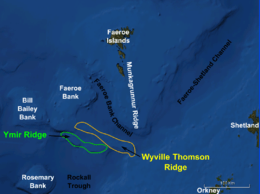Wyville Thomson Ridge
The Wyville Thomson Ridge is a bathymetric feature of the North Atlantic Ocean floor ca. 200 km in length, located between the Faroe Islands and Scotland. The ridge separates the Faroe–Shetland Channel to the north from the Rockall Trough to the south. Its significance lies in the fact that it forms part of the barrier between the colder bottom waters of the Arctic and the warmer waters of the North Atlantic.[1]

The Wyville Thomson Ridge is named after Charles Wyville Thomson who pioneered the first exploration of the area.
Geology
The Wyville Thomson Ridge, and the smaller but similar Ymir Ridge, form the northern boundary to the Rockall Basin, a mainly Mesozoic rift structure. The current form of the ridge is an anticline with up to 2 km of amplitude, formed by a period of shortening during the Eocene to Miocene period. This fold is interpreted to have formed by the reactivation of a pre-existing fault, and is, therefore, classified as an inversion structure.[2]
References
- Sherwin, T.J.; Turrell W.R. (2005). "Mixing and advection of a cold water cascade over the Wyville Thomson Ridge". Deep-Sea Research Part I: Oceanographic Research Papers. 52 (8): 1392–1413. doi:10.1016/j.dsr.2005.03.002.
- Boldreel, L.O.; Andersen M.S. (1993). "Late Paleocene to Miocene compression in the Faeroe–Rockall area". In Parker J.R. (ed.). Petroleum Geology of Northwest Europe: Proceedings of the 4th Conference. Geological Society, London.